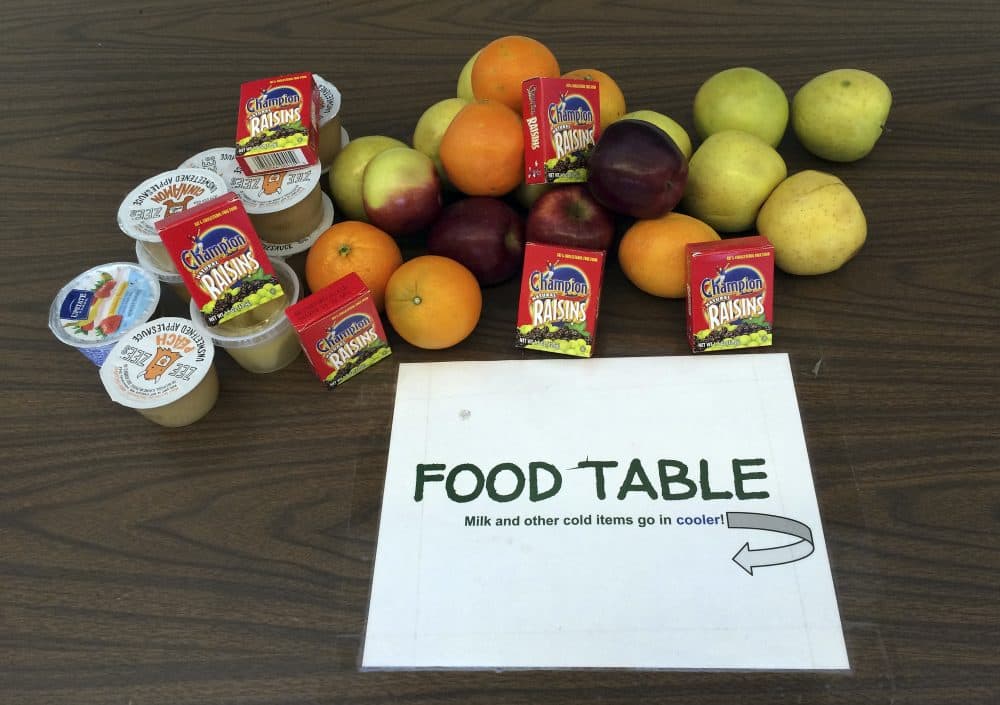Advertisement
Food 'Share Tables' Gathering Steam In Schools, But There's A Catch
Resume
The concept of food "share tables" is picking up in some schools where students can donate unwanted food to their hungry classmates while also helping reduce food waste. But some states, like Connecticut, have enacted restrictions on what can and cannot be shared.
Here & Now’s Robin Young talks about the issue with Nick Iannone, an eighth-grader who started a share table at James H. Moran Middle School in Wallingford, Connecticut, and John Williamson, president of Food Rescue (@Food_Rescue), based in Indiana.
Interview Highlights
On Nick Iannone's reaction to food sharing table restrictions in Connecticut
Nick Iannone: "I'm a little bummed out because they're wanting us to eliminate half the stuff that's on our food share tables. But the USDA actually encourages the use of food share tables and they'd like us to have as much stuff on the food tables for other students to take as they can."
On how the food share tables work
NI: "Most of our school's fruit and snack items are packaged within our lunchroom [and therefore cannot be shared]. Like raisins, pears, carrots, fruit cups, apples — anything like that cannot be shared on the food share tables."
"Students that are maybe less fortunate than others, don't have a lunch or a snack at school lunch, they can come up and take fruit or we've seen things like chips and yogurt come off the tables. So they're free to take anything that they want off the table."
"I haven't seen any problems with it. Most kids usually just stay within their friend group and talk amongst themselves. No one really cares what happens, what goes on around the food table."
On Food Rescue's work with schools to reduce food waste
John Williamson: "In 2016, we got an inquiry on our web site from Tammy Braccio who is on the Wallingford Parent Teacher Advisory Council, and we started working with them, several state officials and local health department officials about how to implement these programs in Connecticut schools. Meanwhile, Nick was having these thoughts about getting things started, and they were able to successfully get started this year. So what we do as an organization is provide online resources and educational materials to inspire people to learn the truth about what the USDA says, what different states say about it, so they can proceed with a lot of knowledge."
"Every day, a lot of my peers at my school, they take hot lunch, and I can tell that none of them really eat their raisins, drink their milk or keep their carrots. Most of it goes to the trash."
Nick Iannone, on why he wanted to start a food share table
On worries about liabilities and legal protections for schools
JW: "The 1996 Bill Emerson Good Samaritan laws covered restaurants and grocery stores for donating perishable surplus food, but schools were really not certain whether that covered them or not. So in November of 2011 it was clarified that schools actually do have the same protections that other businesses have for donating a surplus perishable food, and that protects them up to the standard of gross negligence. "
"The USDA has thought very carefully about this issue and they've implemented food safety guidelines so that it would be safe so that we don't feed landfills instead of children. It makes no sense at all in our country that one in six are hungry while 40 percent of our food is wasted, and we waste in our schools these unopened and unpeeled items like Nick has been trying to rescue. We waste 1 billion of those items each year in our country and it's just absurd. And there are guidelines to follow. And we need to start a grassroots movement just educating people on the food safety standards that the USDA has put out that are perfectly legitimate and well thought out."
On how Nick came to start this initiative at James H. Moran Middle School
NI: "So I was part of the Moran Middle School pilot program for capstone, so basically we were tasked with finding a problem with our Moran community — that's my middle school in Wallingford — so we had to find a problem within our community and solve it using the 'dream, design, do' process, which the one for public schools was trademarked. I mean, I immediately knew what I was going to do, and that was obviously food waste in the cafeteria. Just every day, a lot of my peers at my school, they take hot lunch, and I can tell that none of them really eat their raisins, drink their milk or keep their carrots. Most of it goes to the trash."
This segment aired on March 14, 2017.